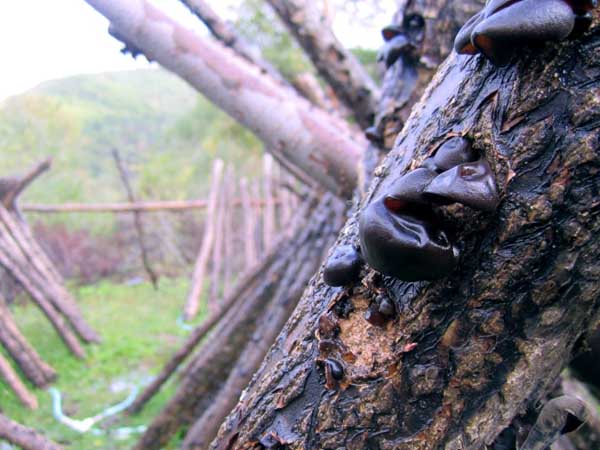Cultivation conditions of Auricularia auricula how to plant and cultivate Auricularia auricula? Formula cultivation ingredients of Auricularia auricula

Black fungus grows in oak, poplar, fig, locust and other 120 kinds of broad-leaved trees rotten wood, clustered, often tile-like overlapping. It can also be cultivated with hardwood logs and sawdust; it needs light, moisture and warmth to grow.
Cultivation Conditions of Auricularia auricula
Auricularia auricula belongs to saprotic mesophilic fungi. Mycelia can grow at 6~36℃, but the optimum temperature is 22~32℃;15~27℃ can differentiate into solid, but the optimum temperature is 20~24℃. Auricularia lushi is a geographical protected product in Lushi County of Henan Province because of good natural environment. Mycelia can grow in culture and wood with 60%~70% water content. When fruiting body is formed, the water content of earwood should be more than 70% and the relative humidity of air should be 90%~95%. Mycelia can grow normally in darkness. The growth period of fruiting body needs 250~1000lx light intensity. It is an aerophilic fungus, pH5~5.6 is optimum.
Black fungus cultivation raw materials
There are many cultivation methods of Auricularia auricula, such as log cultivation and plastic bag substitute cultivation. Here, we mainly introduce log cultivation and plastic bag substitute cultivation methods.
1. Cultivation of logs
Artificial cultivation of Auricularia auricula originated in China around 600 AD, and it is the first edible mushroom variety cultivated artificially in the world. It has a history of more than 1400 years. In the Tang Dynasty, the mountain people in Daba Mountain, Micang Mountain and Longmen Mountain in northern Sichuan adopted the method of "log cutting flowers" to plant Auricularia auricula. This primitive planting method lasted for thousands of years. In the Qing Dynasty, Changbai Mountain in Northeast China and Funiu Mountain in Henan Province also began to plant Auricularia auricula. The deciduous trees were cut down in the third or ninth day of winter, relying on the natural propagation of Auricularia auricula spores. The harvest depends on the sky, and the yield is extremely low.
In 1955, Chinese scientific and technological workers began to cultivate solid pure strains of Auricularia auricula and invented the tree-punching inoculation method, which greatly increased the yield of Auricularia auricula cultivated in tree-segments. However, after completing a cycle in two or three years, the absolute yield is still not high. Each high-quality wood segment with a length of 1 meter and a diameter of 10~13 cm produces only 100~150 grams of Auricularia auricula in three years, and is often affected by natural disasters. This method has so far been used only by a very small number of ear farmers in forest areas.
2, plastic bags planted
This technology changed the history of wood production of Auricularia auricula, so that Auricularia auricula cultivation from forest to field land. Plastic bag planting black fungus with sawdust, straw as raw materials, the use of plastic bags, each bag 0.5 kg dry material, after sterilization, inoculation, cultivation, placed in the field, orchard forest ear. The plastic bag cultivation technology greatly broadens the cultivation raw materials and cultivation areas of Auricularia auricula, greatly shortens the production cycle, returns to the natural cultivation mode products to achieve natural pollution-free, and is more conducive to large-scale, mechanized and standardized production.
The plastic bag was invented successfully by Chaoyang Edible Fungus Research Institute of Liaoning Province. In 1994, it was listed as "National Key Promotion Plan for Scientific and Technological Achievements" and "Eight-seven Poverty Alleviation Plan." In the same year, it won two national invention patents. In 2000, it won "Top Ten Excellent Scientific and Technological Achievements in National Edible Fungus Industry." In 2006, it was awarded and supported by the World Bank, the Poverty Alleviation and Development Group of the State Council and the Ministry of Civil Affairs. Plastic bags planted black fungus with its "from nature, return to nature" way, conform to the black fungus "cold hot, dry wet wet" life habits, cultivation success rate and yield, high quality, has become the mainstream of black fungus cultivation.
Related
- A course of planting techniques and methods on how to grow carrots
- How to plant the latest tulips?
- Is it better to pick tea in the morning or in the afternoon? When is the best time for tea to be picked? what is the third or fifth tea?
- Launch Yuanxiao Happy combination Haocha + Tea Yuan healthy Taste
- Penghu Tourism "Fireworks 20 Parade with You"
- 2022 West Lake Happiness holds "Digital Revitalization Voucher" and draws iphone13 and laptop.
- Banqiao Fuzhou social houses are designed to change start-up combined with police elimination to create a safe and livable environment
- The convenient measure of "mechanical weeding" in Xinbei has been abused and the Agriculture Bureau has imposed heavy penalties on the illegal land consolidation.
- Changgeng University Joins Hands with Four Memory Factories to Rescue Memory Talent Shortage
- The list of Taiwan's top 100 MVP managers is listed by the Director-General of the Farmers' Association of Sanxia District.



